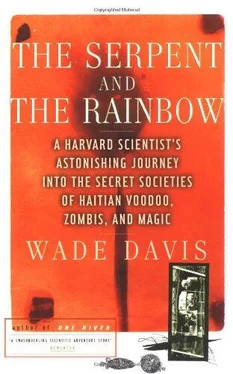Wade Davis - The Serpent and the Rainbow
Здесь есть возможность читать онлайн «Wade Davis - The Serpent and the Rainbow» весь текст электронной книги совершенно бесплатно (целиком полную версию без сокращений). В некоторых случаях можно слушать аудио, скачать через торрент в формате fb2 и присутствует краткое содержание. Год выпуска: 1985, Издательство: Simon & Schuster, Жанр: Старинная литература, на английском языке. Описание произведения, (предисловие) а так же отзывы посетителей доступны на портале библиотеки ЛибКат.
- Название:The Serpent and the Rainbow
- Автор:
- Издательство:Simon & Schuster
- Жанр:
- Год:1985
- ISBN:нет данных
- Рейтинг книги:5 / 5. Голосов: 1
-
Избранное:Добавить в избранное
- Отзывы:
-
Ваша оценка:
- 100
- 1
- 2
- 3
- 4
- 5
The Serpent and the Rainbow: краткое содержание, описание и аннотация
Предлагаем к чтению аннотацию, описание, краткое содержание или предисловие (зависит от того, что написал сам автор книги «The Serpent and the Rainbow»). Если вы не нашли необходимую информацию о книге — напишите в комментариях, мы постараемся отыскать её.
The Serpent and the Rainbow — читать онлайн бесплатно полную книгу (весь текст) целиком
Ниже представлен текст книги, разбитый по страницам. Система сохранения места последней прочитанной страницы, позволяет с удобством читать онлайн бесплатно книгу «The Serpent and the Rainbow», без необходимости каждый раз заново искать на чём Вы остановились. Поставьте закладку, и сможете в любой момент перейти на страницу, на которой закончили чтение.
Интервал:
Закладка:
Roizin worked in a cluttered office. He was short, almost dwarfed by his white lab coat. Discussing his experiments, we spoke clinically.
“What you have here,” he began, “is a very strong neurotropic substance. Most peculiar. You have no idea what it contains?”
I shook my head. I didn’t like to deceive him, but I wanted first to hear what he had discovered. Explanations could come later.
Roizin reached into a folder and passed me two photographs of white rats. Both appeared dead. “First we shaved the dorsal surface and applied a thick emulsion containing the powder. Within a quarter hour spontaneous activity decreased, and within forty minutes the animals moved only when stimulated. Soon after that all mobility ceased, and the rats held a single position for three to six hours. Breathing became superficial. We could still get a heartbeat, and there was some response to sound and corneal stimulation. After six hours all movement completely ceased. They looked comatose and showed no response to any stimuli. Yet we could still register a heartbeat on the EKG. We also picked up brainwaves. They remained that way for twenty-four hours.”
“And they were alive?” I asked.
“Yes, but totally tranquilized. But there is much more. Most tranquilizers do not act as anesthetics. This one does. Look at the second photograph.” I glanced down. “We stuck that needle into its tail, and there was absolutely no response of any kind. Whatever you have here acts peripherally as an anesthetic. And it acts very quickly, without affecting the heart even in the toxic stage.”
“Were there any other behavioral changes?”
“Yes, one that comes to mind. Early in the experiment while there was still some mobility, the rats clustered together, and their extremities were noticeably cool. It was as if they were attempting to keep warm.”
“How much of the powder was administered to each animal?”
“Five milligrams per one hundred gram weight. But there is something else I want to show you.” Roizin lifted his phone to make a call. I took the opportunity to discreetly make a calculation on my notepad based on the dosage administered to rats. Extrapolating to the weight of an average man, Roizin had used the equivalent of 3.5 grams of the crude poison.
“The technician is ready down in the studio,” he said as he hung up. “When we got these results with the rats I decided to record what happened to the monkeys.” He got up and indicated I should follow him out of his office. “Ever worked with rhesus monkeys before?” he asked as he led me away.
“Never had to,” I replied.
“You’re most fortunate, then. But you ought to experience the animals at least once before you see the film.” Roizin took me through a maze of cinderblock corridors that led to the animal facility of the institute. The sound as we approached the room that housed the cages of monkeys was deafening. The last time I had heard any monkey had been in the rain forest of the northwest Amazon. But that had been the deep roar of a howler, free and majestic and fearsome. Here, an entire wall of metal cages rattled with the frantic movements of animals that had never called a mate. Out of the dozen sterile screams, Roizin picked one and tapped its cage menacingly. The captive lunged violently, knocking its teeth against the thin bars. “Passive they are not,” he said loudly and close to my ear. His point made, he turned out of the room.
“What you will see, of course, are but preliminary results,” he told me as we entered the studio. “We used exactly the same procedure as with the rats.” A technician dimmed the lights, and the fuzzy image of Roizin came on the video monitor. Beside him was a single cage, with an aggressive rhesus monkey just like those we had seen. Roizin’s voice on tape was difficult to understand, but the images spoke for themselves. Twenty minutes after application of the emulsion this same monkey appeared noticeably sedated. Even when prodded it did not lunge at the bars. Rather, it slowly retreated to one corner of the cage, assuming, as Roizin explained, a stereotypic catatonic position. When stimulated, it reacted at best passively, opening its mouth in a vain imitation of its normal threatening posture. The monkey maintained that position for three hours. At that point the technician and Roizin had been called away on other business. When they returned six hours later the monkey was still in the same position.
“Now we can increase dosage and do any number of things,” Roizin told me once we were back in his office, “but I think for now the point is made. Whatever this powder contains, it acts very quickly and completely modifies behavior.” Roizin leaned back in his chair. “I can promise you one thing for certain. For many years I have worked for Professor Kline, and some pretty odd drugs have passed through this laboratory. This, without doubt, is the most peculiar.”
“Do you have any idea what it might be used for?” I asked.
“There’s no way of knowing right now.”
“Don’t you have any guesses?”
“Perhaps cardiovascular surgery. It is curious how the heart remains unaffected while the body is totally anesthetized. Also in psychiatry, it might be of use treating something like psychotic excitement.”
“As a tranquilizer?”
“Of a sort. There is one more thing. Did Nate Kline ever talk to you about experimental hibernation?”
These preliminary lab results should have delighted me. They demonstrated experimentally what all the literature could only suggest as a possibility. Marcel’s powder did contain pharmacologically active compounds that acted very rapidly to lower the metabolic rate of the victim. Yet even as I received congratulatory letters and calls from Kline and Lehman, and from Schultes as well, I was more deeply perplexed than ever. Before these results the entire notion of zombis had remained strictly an idea, a curiosity, an abstraction. I went to Haiti skeptically, knowing nothing about the country or the people, and the assignment dropped me into an enchanted land whose spiritual rhythms took me utterly by surprise and moved me profoundly. Despite this, or perhaps because of it, I had never actually paused to consider whether or not zombis truly existed. It wasn’t that I didn’t believe, and it wasn’t that I did. I just hadn’t passed judgment. The formula of the poison, the correlations from the literature and the case of Narcisse, and now the preliminary but concrete laboratory results changed everything. Now I had to face just how little I understood about a phenomenon that suddenly appeared hauntingly real.
There were so many loose ends. Every report received from Haiti, for example, had mentioned an antidote. Yet while Marcel had prepared a potion that he believed counteracted the effects of the poison, the way it was used and the ingredients themselves suggested that it was pharmacologically inactive. Tetrodotoxin has no known medical antidote, nor, from what is known of the action of the toxin, would the zombi makers require one. Victims of puffer fish poisoning either live or they die, and those who survive recover on their own, as presumably would the zombis. Still, this information notwithstanding, the persistent reports of an antidote begged further investigation. As colleagues often remind me, absence of evidence is not evidence of absence.
Yet in all this obsession with the drug and elusive antidote, I was, in one sense, missing the point entirely. All that the formula of the poison explained was how an individual might be made to appear dead. Clearly the same thing occurred in Japan, however infrequently, but just as clearly those who succumbed to toxic fugu preparations were not zombis; they were merely poison victims. Any psychoactive drug has within it a completely ambivalent potential. Pharmacologically it induces a certain condition, but that condition is mere raw material to be worked by particular cultural or psychological forces and expectations. This is what experts call the “set and setting” of any drug experience. Set in these terms is the individual’s expectations of what the drug will do to him; setting is the environment—both physical and, in this case, social—in which the drug is taken. For example, in the northwest rain forests of Oregon there are a number of native species of hallucinogenic mushrooms. Those who go out into the forest deliberately intending to ingest these mushrooms generally experience a pleasant intoxication. Those who inadvertently consume them while foraging for edible mushrooms invariably end up in the poison unit of the nearest hospital. The mushroom itself has not changed.
Читать дальшеИнтервал:
Закладка:
Похожие книги на «The Serpent and the Rainbow»
Представляем Вашему вниманию похожие книги на «The Serpent and the Rainbow» списком для выбора. Мы отобрали схожую по названию и смыслу литературу в надежде предоставить читателям больше вариантов отыскать новые, интересные, ещё непрочитанные произведения.
Обсуждение, отзывы о книге «The Serpent and the Rainbow» и просто собственные мнения читателей. Оставьте ваши комментарии, напишите, что Вы думаете о произведении, его смысле или главных героях. Укажите что конкретно понравилось, а что нет, и почему Вы так считаете.












